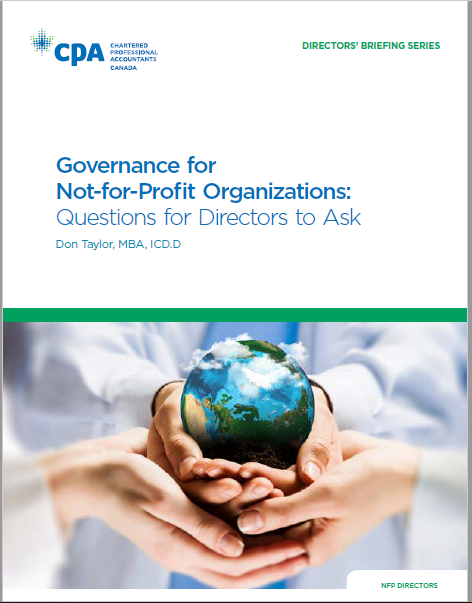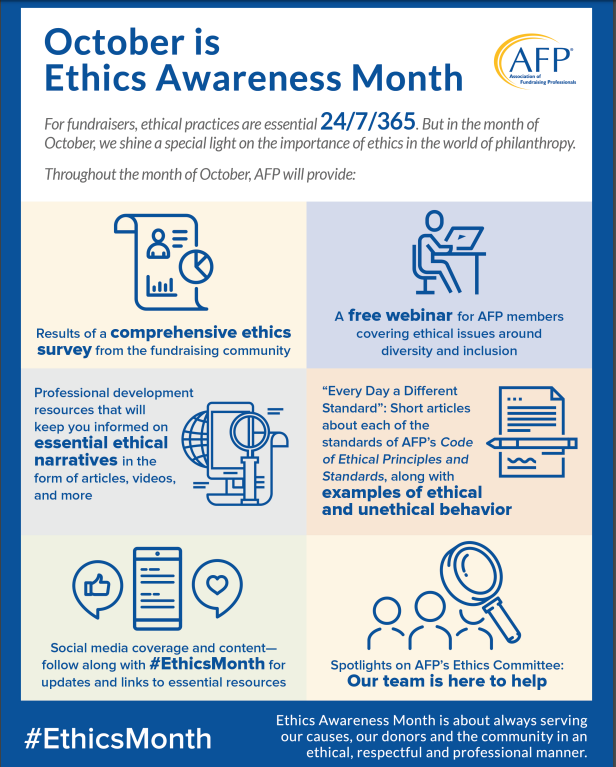A BOARD’S A BOARD, RIGHT? UM, WELL, ACTUALLY…NO.
A BOARD’S A BOARD, RIGHT? UM, WELL, ACTUALLY…NO.
Andrea McManus, ViTreo Group Inc
October 8th 2019
Is there a difference between non profit and for profit governance? Yes.
We’ve created some conversation about boards in this latest series including a September 24th guest blog 32 Years of Ranting About Boards…Some Big Challenges and Fixing Them written by the always insightful and strategic Simone Joyaux, followed by the equally insightful and strategic blog by moi on boards and fundraising with Your NPO Has a Board - Now What? Otherwise Known As a Conundrum.
Now, it’s timely to talk about the really BIG question about boards.
What’s the difference between non profit and for profit governance? Or is governance just governance?
Breaking News! If the board in question has been created for a not for profit organization, there is a big difference. For profits and not for profits are not the same. They exist for different reasons which translates to requiring a specific governance structure for each in order to remain sustainable. So, a board is not just a board.
The U.S. company, BoardEffect, a board management platform that allows boards to work smarter, explains it this way (it applies to both Canadian and American charitable organizations):
How the Board Structures of For-Profit and Not-for-Profit Organizations Differ
The differences between for-profit and nonprofit organizations become apparent when we look at an organization’s mission, finance structure, and board of directors and their duties. The boards for both types of organizations bear much responsibility…For-profit board directors’ primary responsibility is to their shareholders. They owe their shareholders and other stakeholders the duty of care and the corporation, their duty of loyalty…
The mission is a central component to nonprofit organizations. Virtually every decision the board makes centers around the mission, vision and values of the organization. The major activity for nonprofit organizations is generating donations. Nonprofit organizations qualify as tax-free because they fill the gaps of many social services that governments aren’t able to provide given the limitations of available tax dollars.
The mission for for-profit organizations is also very important, although for-profit board of directors base their decisions on many factors. For-profit boards consider risk management, the market climate, the wishes of the investors, historical trends, future predictions and many other metrics before making final decisions for the company. The company’s mission is an important component of the business, but financial metrics often take precedence. For-profit organizations also take nonfinancial metrics into consideration when having board discussions.
Where Was The Board?
“A few weeks ago, Nonprofit Quarterly reported about the fallout from reports by FEGS Health & Human Services in New York of an unexpected $19.4 million loss: changes in the executive office and cuts to programs and budgets. Like many others in the sector, one of my first reactions was to ask, “Where was the board?”
This question comes up all too often: People’s Health Clinics in Baltimore closed in June 2014 with almost $500,000 owed to the IRS for payroll taxes, a cancelled federal grant, unpaid rent and other bills. Locally, we’ve been following the troubles at Community Action of Minneapolis and St. Paul-based education services provider TIES’ critical audit report and financial challenges. Did the boards of these organizations miss the red flags like diminishing cash, ballooning debts, and recurring deficits? In each of these news stories there is documentation, audit reports, and other evidence of problems. If we can read about the information now, why didn’t the members of the board see the problems and address the problems?
Maybe the boards did miss the red flags. We have the gift of hindsight.”
(Nonprofit Quarterly, How Board Members Can Learn to Spot Red Flags, Kate Barr, April 20, 2018)
To return to the question - What’s the difference between non profit and for profit governance?
It’s critical for board members of both to understand governance requirements. As we live in the not for profit world, our focus is on what’s required for our sector.
In the Canadian Chartered Professional Accountants’ guide Governance for Not-for-Profit Organizations: Questions for Directors to Ask, Don Taylor, MBA, ICD.D states:
“For not-for-profit organizations (NFPs), governance is increasingly in the spotlight. Stakeholders and the general public are demanding more transparency and accountability regarding the oversight of organizations of all kinds. Despite this intensifying focus on governance, many NFP directors do not fully appreciate the extent of their oversight responsibility.
Under current legislation and common law, NFP directors have an overall responsibility for the organization and the strategy for achieving its legal purpose. Directors who neglect these responsibilities put the NFP’s sustainability at risk.
On the other hand, directors that ensure their NFP is equipped with a good governance framework can ensure that the NFP is productive, accountable and delivers on its mission, ethically and sustainably. This guide sets out a process to help NFP directors create such a framework or in refining an existing one.”
Taylor goes on to provide counsel on how to design and implement a proper governance framework:
“As well, all incorporated NFPs in Canada operate under the Canada Not-for-Profit Corporations Act or similar provincial legislation. Implicit in these acts and related legislation is a generic governance framework with clear relationships: The board of directors is elected by the members of the NFP.
As the senior oversight entity, the board appoints and oversees the chief executive officer/executive director (CEO/ED). Management hires employees to operate the organization.
Designing the Governance Framework
When considering the NFP’s governance framework, directors should consider three questions:
What is the fundamental work of the board?
How will the board add value?
How will the effectiveness of the governance framework be evaluated?
Once the board has explored these questions, directors will be in a better position to start designing or refining the NFP’s detailed governance framework. No single model suits all organizations. The framework should address:
The board’s independence from management
The board’s primary focus
Board dynamics
The primary tools for board work and board support requirements
The relationship between the board and the CEO/ED.
Directors should look to the work of their board and current best practices in governance to help them develop the details of a governance framework most suited to their organization. Whatever framework is chosen, the separation of board and management roles is one of the most important features of a good organizational governance framework. The work of the board is to see that the organization’s mission gets accomplished. Ideally, the work of the organization is the job of management.
Implementing the Governance Framework
Once the board has determined the overall design of its governance framework, the board will be ready to develop the documents to implement the framework. This work involves:
Creating or confirming the NFP’s mission and articles of incorporation, which define the NFP’s purpose.
Reviewing the bylaws, which govern the responsibilities of members and scope of board accountability.
Reviewing board policies, which govern the work and responsibilities of directors.
Reviewing organizational policies requiring board approval, which determine which management decisions should be vetted by the board due to their level of risk or reputational concerns.”
A Word on Fundraising and Board Governance
Fundraising in and of itself is not a governance function. However, financial oversight is. If fundraising is a key piece of work (or for fundraising foundations the primary work of the organization) then boards need to understand that work. Consider whether it is likely that a for profit organization would recruit board members who do not understand the work, and the environment within which that work is conducted, to its board. Sadly, and all too often, nonprofits do not include this as a criteria for occupying a board seat nor do they regularly and systematically educate their boards on this fundamental work.
Other excellent resources include:
Ten Basic Responsibilities of Nonprofit Boards by Richard T. Ingram (revised edition 2009)
If You've Seen One Board, You've ONLY Seen One Board by BrainTrust Philanthropy (Podcast)
2018 Top 5 Nonprofit Governance Challenges (and Solutions) by Board Effect
Good Governance A Guide for Directors of Canadian Foundations By Philanthropic Foundations Canada
We welcome any and all conversation about boards. It’s a big topic. And an important one. There is much more we could say about them. Please let us know what your experience has been as a board member or with your boards or board members.
October has been declared Ethics Awareness Month by the Association of Fundraising Professionals —
“because ethics makes philanthropy and fundraising possible. Without ethics, giving doesn’t happen. Fundraising doesn’t happen. Change and impact don’t happen. Ethics makes it all possible, and THAT’S worth celebrating.”
- Association of Fundraising Professionals, Ethics Awareness Month!, October 2019
— The Provocateur will shift focus and delve into that substantial topic — think the power of social media and Epsteingate. Watch for other guest writers in the coming weeks.
Happy Thanksgiving to all of our Canadian readers. Wishing you much turkey, stuffing and gravy over the upcoming holiday!!
Check out ViTreo's Braintrust as we bring you additional insights into what is and what will be important in philanthropy through our Weekly News Recap and our Podcast.
ABOUT THE AUTHOR
Andrea McManus, Chair, Board of Directors, Partner
ViTreo Group Inc
Andrea McManus is a Partner with ViTreo with over 30 years’ experience in fund development, marketing, sponsorship and nonprofit management. A highly strategic thinker and change maker, Andrea has worked with organizations that span the nonprofit sector with particular focus on building long-term and sustainable capacity.







